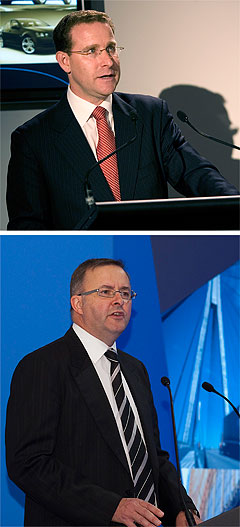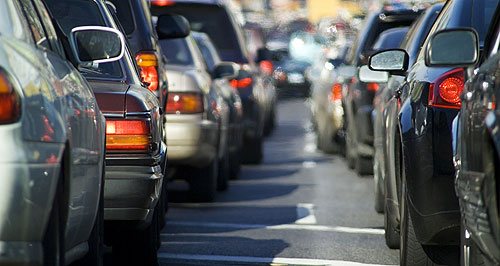News - General News - EmissionsFCAI rejects fast track to Euro 5Handbrake turn: Car industry has urged the federal government to try again on emissions restrictions. Car industry warns emissions reform a threat to local engine plants, future models23 Feb 2010 By TERRY MARTIN THE Federal Chamber of Automotive Industries (FCAI) has urged the federal government to head “back to the drawing board” on its deliberations over future environmental regulations, warning that no decision be taken over confirming a start date for tougher Euro 5/6 standards until it considers implications such as viability of Australian engine plants. Speaking to GoAuto this week, FCAI chief executive Andrew McKellar said the industry had “a very significant concern” about the government’s proposal to move to Euro 5 from 2012 and then Euro 6 from 2016. Through federal transport minister Anthony Albanese, the government released a draft regulation impact statement (RIS) last month on moving to the tougher standards, calling for public and industry comment before March 1 ahead of its final decision. Mr McKellar questioned the cost-benefit analysis done by the Bureau of Infrastructure, Transport and Regional Economics (BITRE), upon which the RIS is heavily based, and said it failed to properly consider the future model plans of car manufacturers as well as the impact on the engine plants of local manufacturers.  From top: FCAI chief executive Andrew McKellar and federal transport minister Anthony Albanese. From top: FCAI chief executive Andrew McKellar and federal transport minister Anthony Albanese.As GoAuto has reported, the fate of Toyota Australia’s engine plant is hanging in the balance as local management negotiates a fresh contract, while Ford Australia also recently revealed that engineering its Geelong-built six-cylinder engine to meet the Euro 5 standard would be difficult. While the FCAI accepts that the Euro 5 and Euro 6 standards will eventually be applied in Australia, Mr McKellar said the proposed timetable “would be difficult to meet”. The government believes the move to Euro 5/6 would cut emissions of all new passenger cars, 4WDs and utilities sold in Australia by as much as 90 per cent. The latter refers to particulate matter, while the cuts for oxides of nitrogen would be up to 70 per cent and hydrocarbons up to 50 per cent. “The regulation impact statement for Euro 5 and Euro 6 has really just popped out of the woodwork – there’s been no real consultation with industry, and I think the analysis that was undertaken to support the RIS by the BITRE has been wholly inadequate,” Mr McKellar said. “The process that has been undertaken to date for the regulation impact statement does leave us with very significant concern, and I think there will be a need to go back to the drawing board and ensure that the proper analysis is undertaken, looking at the product plans that the industry has in the pipeline and also evaluating the local industry impact. “To date, that analysis has taken no account of the product cycle issue – future product plans that brands have in place – so there’s really been no evaluation of the proportion of vehicles that are coming to the market that will already be Euro 5-compliant. “(And) there’s been no account taken of the local industry implications. For example, what are the future engine plant investment issues – and the timing of decisions in terms of that future investment by the local manufacturers. “So from that point of view, we do have some major concerns with the evidence that has been looked at to date and the process that is underway.” Significantly, tougher measures to reduce carbon dioxide (CO2) emissions from new vehicles in Australia are subject to a separate RIS. The FCAI is negotiating on the proposed legislation with the government, and is confident a satisfactory outcome for the industry will be reached before the new regulations are announced around mid-year. These could include a move from the current situation where the industry sets a voluntary CO2 target applied as a national average, to mandatory requirements applying to individual models. It will also include setting a new short-term target – to 2015 – for CO2 emissions, while a longer-term outlook to 2020 is also under discussion. Last week, the FCAI officially confirmed that the industry had met its 2010 target of 222g/km – set in 2005 and coinciding with the move to the Euro 3 standard – with 2009’s National Average Carbon Emission (NACE) figure announced as 218.5g/km. While not divulging a specific new 2015 CO2 target, Mr McKellar indicated that the new figure would reflect the current improvements of between one and two per cent each year as well as the continued introduction of hybrid and diesel powertrains and the emergence of full-electric vehicles. On that basis, the target under consideration will be less than 200g/km. “From here to 2015, you would expect an underlying improvement of about a further 10 per cent, but I think the industry will be seeking to set a more ambitious target than that,” said Mr McKellar. “Precisely where that will end up remains to be seen. The FCAI has also proposed that the government offer specific consumer incentives for purchasing low-carbon cars, with a benchmark of, say, 50g/km or less (for electric vehicles and range-extending hybrids, for example) and a second tier of around 120-130g/km (for more conventional vehicles). “The one thing I would say is that the industry is very committed to achieving an ambitious outcome,” Mr McKellar said. "We all realise that this is one of the most significant challenges that the automotive industry faces, and equally it has to be recognised that individual brands are investing very significant amounts in bringing a whole range of new technologies and models into the Australian market which will radically improve the CO2 performance over coming years. “We are committed to getting a very good outcome on this issue and the industry is very serious about living up to its responsibilities and being part of the broader solution on this issue.” Having said that, Mr McKellar said it was “artificial” that there were separate RIS papers and proposed legislation affecting new-vehicle emissions, not to mention another regulatory reform process underway for vehicle fuel efficiency (including mandatory CO2 emissions) through the Council of Australian Governments (COAG). Under the direction of the federal transport and environment ministers, the fuel efficiency report was written by the Vehicle Fuel Efficiency Working Group, which includes members from the Australian Transport Council and the Environment Protection and Heritage Council. “We think it is completely artificial to try and separate those issues,” Mr McKellar said. “You do need to look at them in an integrated fashion – and that’s one of the concerns we have. In each of them, there’s an attempt to sort of say, ‘Fuel quality is out of scope’ or ‘What’s happening on CO2, that’s out of scope’ or ‘What are we doing on Euro 5 or Euro 6, that’s also out of scope?’ “They all need to be brought together at some point, and they need to be looked at as related issues. Otherwise, we’re going to end up with some significant inadequacies in the decision-making process in the advice going to government.” Australia adopted the Euro 4 emissions standard in July 2008, but it does not apply to all new vehicles sold here until July 2010.  Read more18th of January 2010  Ford Falcon12th of January 2010  Ford Falcon24th of December 2009  Toyota24th of November 2009  CO2 emissions down more than expectedAustralia’s new-vehicle industry reaches its emissions target two years early3rd of July 2009  General News Emissions1st of June 2009  General News Emissions |
Click to shareGeneral News articlesResearch General News Motor industry news |















Facebook Twitter Instagram